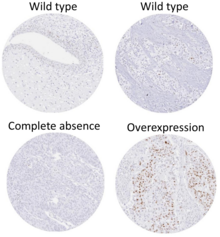Papillary urothelial neoplasm of low malignant potential
 From Wikipedia the free encyclopedia
From Wikipedia the free encyclopedia
| PUNLMP (Papillary Urothelial Neoplasm of Low Malignant Potential) | |
|---|---|
 | |
| Micrograph of a PUNLMP. Intermediate magnification. H&E stain. | |
| Specialty | Urology, pathology |
Papillary urothelial neoplasm of low malignant potential (PUNLMP) is an exophytic (outward growing), (microscopically) nipple-shaped (or papillary) pre-malignant growth of the lining of the upper genitourinary tract (the urothelium), which includes the renal pelvis, ureters, urinary bladder and part of the urethra.
PUNLMP is pronounced pun-lump, like the words pun and lump.
As their name suggests, PUNLMPs are neoplasms, i.e. clonal cellular proliferations, that are thought to have a low probability of developing into urothelial cancer, i.e. a malignancy such as bladder cancer.
Signs and symptoms[edit]
PUNLMPs can lead to blood in the urine (hematuria) or may be asymptomatic.[citation needed]
Diagnosis[edit]

PUNLMPs are exophytic lesions that appear friable to the naked eye and when imaged during cystoscopy. They are definitively diagnosed after removal by microscopic examination by pathologists.[citation needed]
Histologically, they have a papillary architecture with slender fibro vascular cores and rare basal mitoses. The papillae rarely fuse and uncommonly branch. Cytologically, they have uniform nuclear enlargement.[citation needed]
They cannot be reliably differentiated from low grade papillary urothelial carcinomas using cytology,[1] and their diagnosis (vis-a-vis low grade papillary urothelial carcinoma) has a poor inter-rater reliability.[2]
Pathologic grading and staging tumors are: graded by the degree of cellular atypia (G1->G3), and staged:[citation needed]
- papilloma
- papillary tumor of low malignant potential (PTLMP)
- papillary urothelial carcinomas low grade
- papillary urothelial carcinomas high grade.
Differential diagnosis[edit]

- Papilloma.
- Low grade papillary urothelial carcinoma.
Treatment[edit]
PUNLMPs are treated like non-invasive low grade papillary urothelial carcinomas,[1] excision and regular follow-up cystoscopies.
There is a rare occurrence of a pelvic recurrence of a low-grade superficial TCC after cystectomy. Delayed presentation with recurrent low-grade urothelial carcinoma is an unusual entity and potential mechanism of traumatic implantation should be considered. Characteristically low-grade tumors are resistant to systemic chemotherapy and curative-intent surgical resection of the tumor should be considered.[citation needed]
References[edit]
- ^ a b Jones TD, Cheng L (June 2006). "Papillary urothelial neoplasm of low malignant potential: evolving terminology and concepts". J. Urol. 175 (6): 1995–2003. doi:10.1016/S0022-5347(06)00267-9. PMID 16697785.
- ^ MacLennan GT, Kirkali Z, Cheng L (April 2007). "Histologic grading of noninvasive papillary urothelial neoplasms". Eur. Urol. 51 (4): 889–97, discussion 897–8. doi:10.1016/j.eururo.2006.10.037. PMID 17095142.
- ^ Image is taken from following source, with some modification by Mikael Häggström, MD:
- Schallenberg S, Plage H, Hofbauer S, Furlano K, Weinberger S, Bruch PG; et al. (2023). "Altered p53/p16 expression is linked to urothelial carcinoma progression but largely unrelated to prognosis in muscle-invasive tumors". Acta Oncol: 1–10. doi:10.1080/0284186X.2023.2277344. PMID 37938166.{{cite journal}}: CS1 maint: multiple names: authors list (link) - ^ Source for role in distinguishing PUNLMP from low-grade carcinoma:
- Kalantari MR, Ahmadnia H (2007). "P53 overexpression in bladder urothelial neoplasms: new aspect of World Health Organization/International Society of Urological Pathology classification". Urol J. 4 (4): 230–3. PMID 18270948.